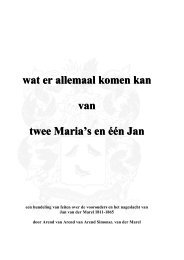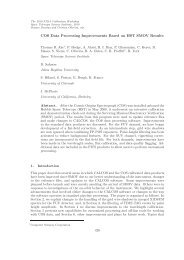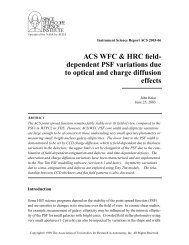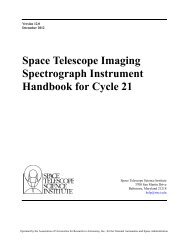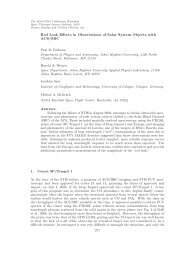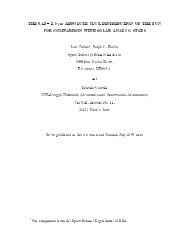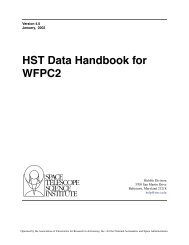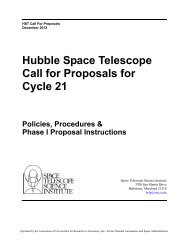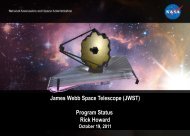STScI Annual Report 2002: A Living Mission
STScI Annual Report 2002: A Living Mission
STScI Annual Report 2002: A Living Mission
Create successful ePaper yourself
Turn your PDF publications into a flip-book with our unique Google optimized e-Paper software.
34 teams<br />
Teams Outside<br />
The TREASURY PROGRAM ADVISORY COMMITTEE<br />
advises the Director on the Hubble Treasury Program by<br />
identifying scientific opportunities that merit large investments<br />
of Hubble time and fostering multidisciplinary,<br />
multiobservatory collaborations.<br />
The OPO EXTERNAL ADVISORY COMMITTEE<br />
drawn from OPO’s diverse user community of<br />
astronomers, educators, journalists, and planetarium<br />
and science center directors—provides feedback on OPO<br />
products and services and counsels OPO management<br />
on ways to advance its mission, goals, and objectives.<br />
The SPACE TELESCOPE INSTITUTE COUNCIL, our<br />
primary management oversight committee, is selected<br />
by the AURA Member Representatives and reports to<br />
the AURA Board of Directors.<br />
The SPACE TELESCOPE ADVISORY COUNCIL is<br />
available to the Director for advice on any subject related<br />
to the Hubble science program.<br />
The INSTITUTE VISITING COMMITTEE evaluates the<br />
management productivity, working environment of the<br />
Institute, and the morale of the Institute staff and reports<br />
to NASA through AURA.<br />
The SPACE TELESCOPE USERS COMMITTEE<br />
reviews the scientific utility of Hubble Space Telescope<br />
and the quality of the Institute’s services and makes<br />
recommendations to both the Director and the NASA<br />
Project Scientist.<br />
The TELESCOPE ALLOCATION COMMITTEE evaluates<br />
proposals for observing time and proposals for archival<br />
research that request funding and makes recommendations<br />
to the Director, including the allocation of Hubble<br />
orbits to selected observing programs.<br />
The MAST USERS GROUP provides advice to increase<br />
the scientific utility and productivity of the Multimission<br />
Archive at Space Telescope and recommends priorities for<br />
new services, data sets, and interarchive collaborations.<br />
The WFC3 SCIENCE OVERSIGHT COMMITTEE<br />
provides scientific oversight and direction on choices,<br />
like filter selection, and trades during the development<br />
and testing of the Wide Field Camera 3.<br />
The JWST SCIENCE WORKING GROUP, consisting of<br />
the first users of the James Webb Space Telescope and<br />
including Institute staff members, advises NASA on the<br />
scientific priorities for the mission.<br />
Teams Inside/Outside<br />
The FINANCIAL REVIEW COMMITTEE reviews all<br />
budgets submitted by General Observers and Archival<br />
Researchers and recommends appropriate funding to<br />
the Director.<br />
The SERVICING MISSION OBSERVATORY<br />
VERIFICATION WORKING GROUP—consisting of<br />
Institute scientists and engineers, NASA engineers, and<br />
instrument developers—defines, designs, and executes<br />
in-orbit verification activities to commission the Hubble<br />
observatory after servicing missions.<br />
The COS OPERATIONS WORKING GROUP, including<br />
engineers and scientists from the Cosmic Origins<br />
Spectrograph team, Ball Aerospace, NASA, and the<br />
Institute, sets the requirements for the flight and ground<br />
software needed to operate the instrument.<br />
The COS CALIBRATION WORKING GROUP, including<br />
engineers and scientists from the Cosmic Origins<br />
Spectrograph (COS) and Far Ultraviolet Spectroscopic<br />
Explorer teams, Ball Aerospace, NASA, and the Institute,<br />
discusses COS calibration issues, sets calibration pipeline<br />
requirements, and advises on implementation<br />
aspects, such as keywords, data formats, reference files,<br />
and reuse and sharing of algorithms and code from<br />
previous applications.<br />
The WFC3 OPERATIONS WORKING GROUP, including<br />
engineers and scientists from Ball Aerospace, NASA,<br />
and the Institute, sets the requirements for the flight<br />
and ground software needed to operate the Wide Field<br />
Camera 3 instrument.<br />
The WFC3 INSTRUMENT CALIBRATION TEAM, with<br />
scientific leadership from the Institute and including engineers<br />
and scientists from NASA, Ball Aerospace, and the<br />
Institute, is developing the plans and procedures for the<br />
ground testing and pre-launch scientific calibration of<br />
Wide Field Camera 3.<br />
The ACS PHOTOMETRIC CALIBRATION WORKING<br />
GROUP, including members of the Advanced Camera for<br />
Surveys Instrument Definition Team and representatives<br />
from other instrument groups, studies issues that affect<br />
the photometric performance and overall calibration of<br />
the ACS.



